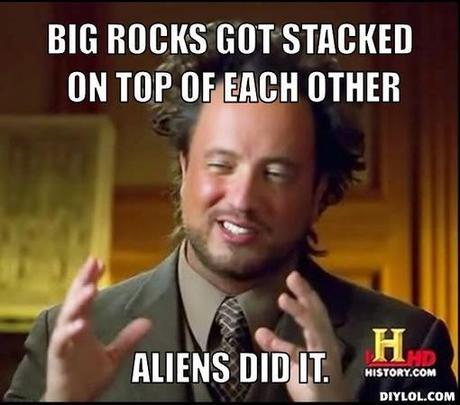If you have ever suffered through an episode of “Ancient Aliens” on the History Channel, you might believe that every megalithic structure in the world was constructed by extraterrestrials:

Apparently inspired by the show, one credulous soul posted this question over at Answers.com: “Can scientists prove that Stonehenge was not built by ancient astronauts?” The pithy answer shows admirable patience: “Probably not, but I don’t think anyone has proved that it was.”
For centuries Stonehenge has been the subject of speculation, some of it reasonable but much of it bizarre. It was this fact which prompted archaeologist Jacquetta Hawkes to observe: “Every age has the Stonehenge it deserves — or desires.” If this is so, what does it say about our age?
In an effort to gauge the Zeitgeist without sticking my finger in an electrical socket (as Giorgio Tsoukalos, pictured above, appears to have done), I decided to research some of the more recent thinking on Stonehenge. I was surprised to learn that while publishers continue to capitalize on the public’s fascination with Stonehenge, professional thinking has not changed much since the 1980s. There appears to be, in other words, some kind of consensus on the basics.
For those who have no desire to wade through the thousands of books and papers on the subject, I recommend Benjamin Ray’s “Stonehenge: A New Theory.” Published in the esteemed History of Religions journal in 1987 (and unfortunately only available to subscribers or through JSTOR), Ray recounts the full history of Stonehenge hypotheses. If there is a better survey, I haven’t been able to find it.
This is not, however, a simple history. Ray critically assesses the competing views, gathers what is most plausible and parsimonious from each, and pieces them together. The synthetic result is masterful, and over 20 years of subsequent scholarship have not altered Ray’s assessments.
Though his conclusion may not be exciting, it is based on solid evidence and respectable theory:
On the assumption that ritual function relates to architectural form and that the history of the site is consistent, the several configurations of Stonehenge do, in fact, suggest a single, underlying ritual function: the periodic coordination of solar and (possibly) lunar cycles with the remains of the dead. This, I believe, is the fundamental ritual theme uniting the different phases of the monument’s history.
Contrary to Durkheim’s tautological contention that ritual constitutes the means by which society worships itself, ritual at Stonehenge served the interests of an aggrandizing elite:
[T]he change from segmentary, lineage-based systems to centralized authority involved the establishment of new religious forms focused upon the ruler, his ancestors, and universal symbols of religious power, superseding the territorial cults and ancestor shrines of the segmentary chiefs…[T]he Wessex chiefs would have erected Stonehenge as an expression of the celestial and ancestral foundations of the chiefship and as the ritual instrument for maintaining the vital connections between these sacred forces.
If the key to the sociopolitical order of the early Bronze Age was the institution of paramount chiefship, then the ritual function of Stonehenge can be reasonably supposed to have served this institution, perhaps being focused upon the person of the paramount ruler himself. To suppose otherwise would entail postulating other institutional arrangements for which there is at present no evidence.
While there is no evidence of aliens at Stonehenge, there is world-wide evidence that wherever Neolithic elites consolidated power, they did so in part by creating religions and controlling rituals. Stonehenge fits the pattern.
Reference:
Ray, B. (1987). Stonehenge: A New Theory. History of Religions, 26 (3) DOI: 10.1086/463079





COMMENTS ( 1 )
posted on 28 November at 16:43
anyone who believes this article is either stupid or dumb.
VERY NIEVE.